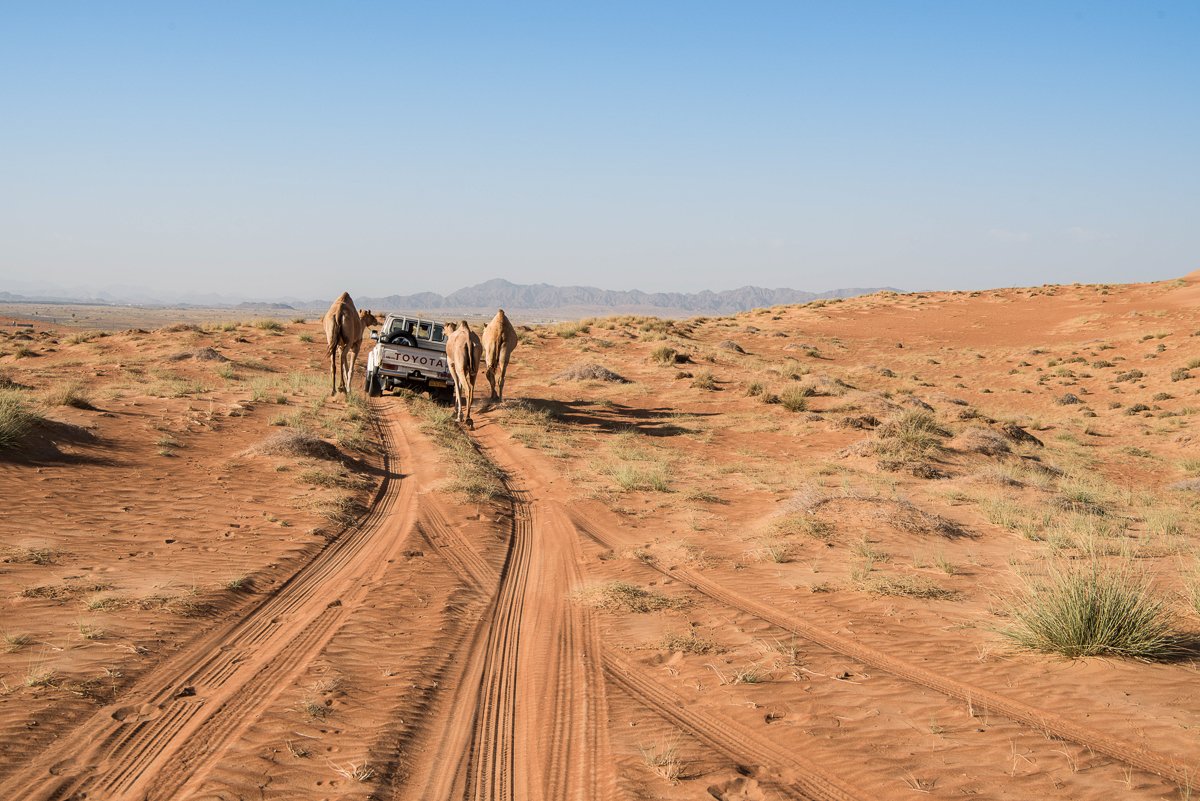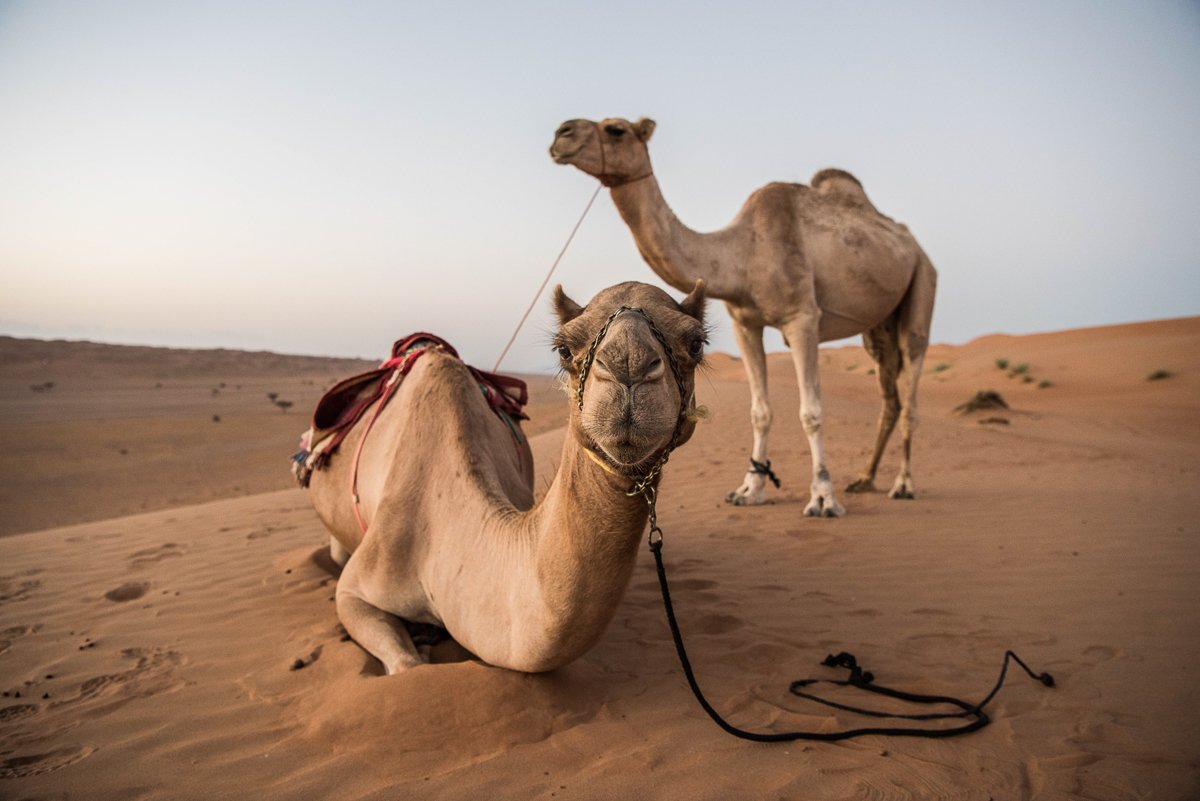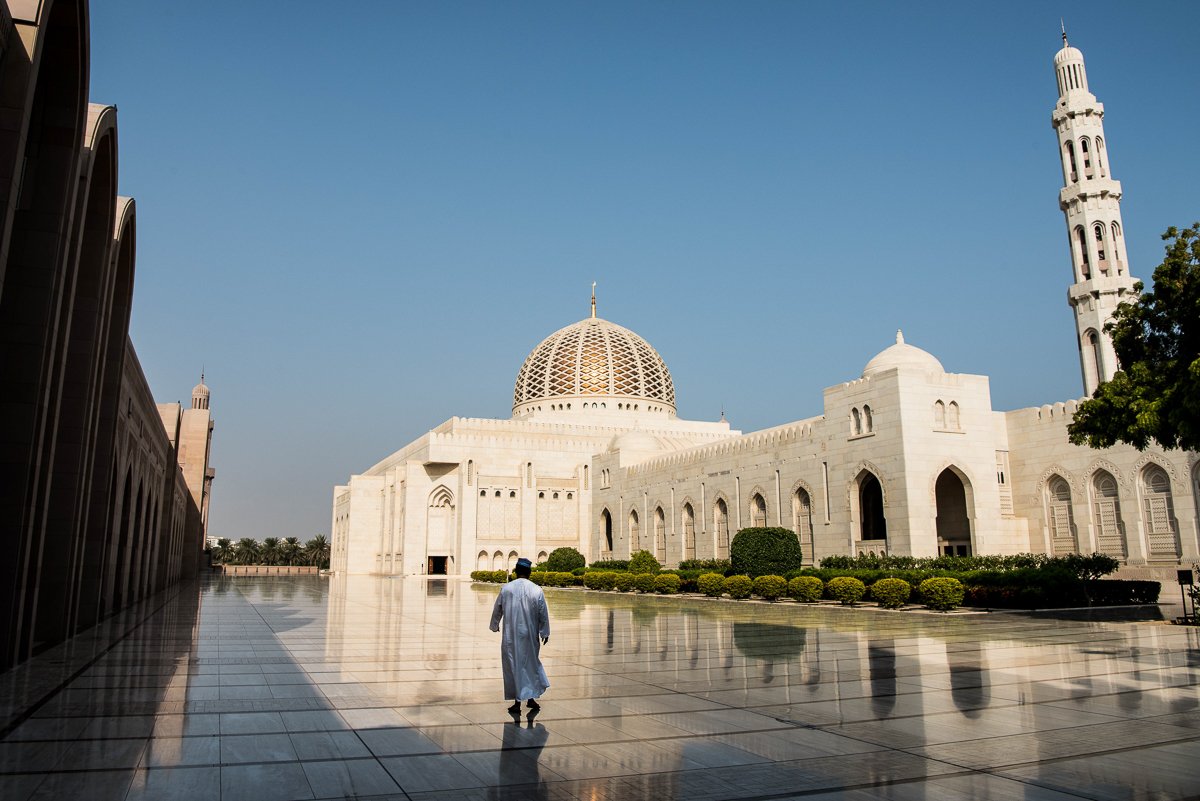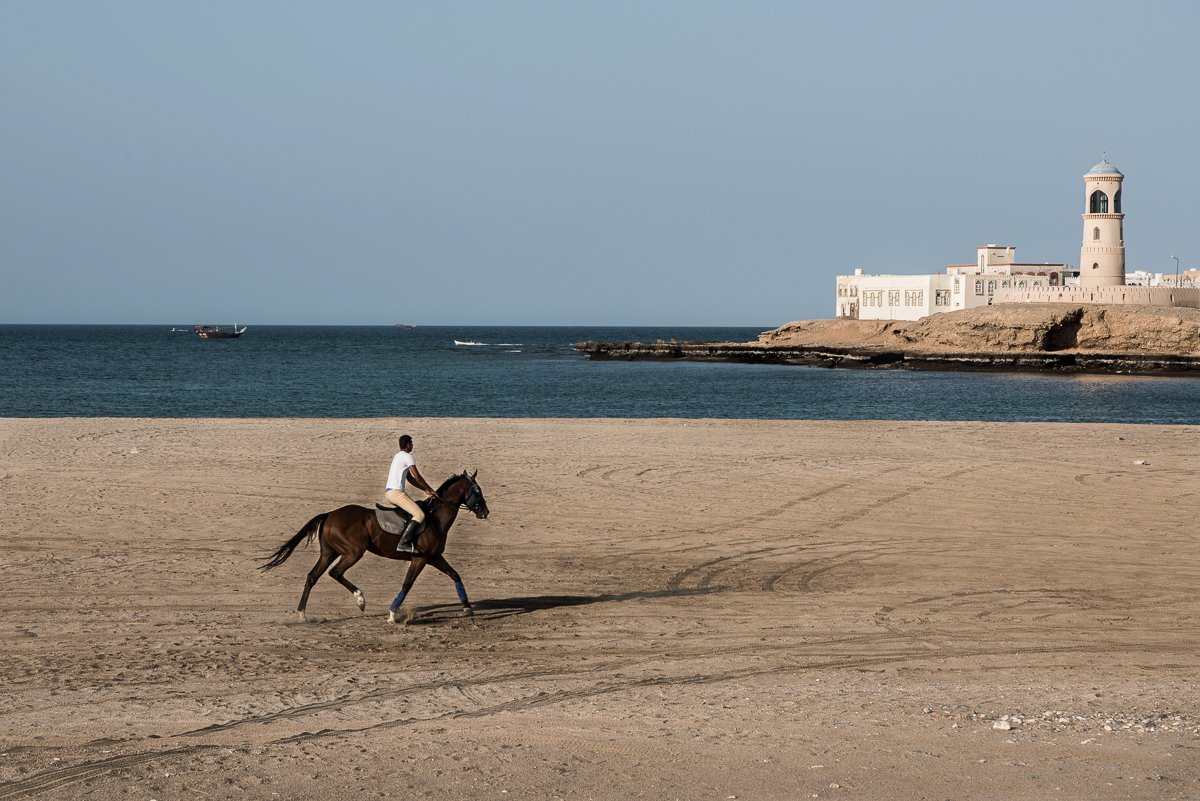Dispatches | Dottie Bond explores Oman
Dispatches | Dottie Bond explores Oman
Images & Text by Dottie Bond
“Oman: a diamond in a rough neighborhood long avoided by American travelers.”
It was 9 o’clock in the morning, and everything in sight was bathed in the brilliant, blazing light of an Arabian Peninsula sun. I had my sunglasses on and still felt the need to hold up a hand to shield my eyes from the glare. Around me stood men buying fresh produce, men selling khat for camel feed, men chatting amiably in long white dishdashas with colorful kumas perched atop their heads. I was standing in a souk in Ibra, Oman—the lone female and the lone foreigner—surrounded by Omani men going about their morning business in a market scene so customary to them it surely felt banal. Little here seemed ordinary to me, though, and I was savoring every second. I was the Other, the outsider, the ferenji, and my senses were heightened in anticipation of the unfamiliar, my eyes wide open to novelty. Situated somewhere between the dunes of the Wahiba Sands Desert and the mountains of the Al Hajar range, Ibra is an old city in a very old part of the world. Not for the first time, nor surely the last, I found myself wondering how did I get here?
The answer to that question lies in a combination of factors, notably political violence in Ethiopia, my thesis advisor from graduate school, and Naya Traveler. When instability in northern Ethiopia prompted the cancellation of part of a long-planned trip a mere two weeks before I was scheduled to depart, I sat down at my computer, pulled up a map of Ethiopian Airlines’ nonstop flight destinations from Addis Ababa, and selected where I wanted to spend four days. I thought about Rwanda, Zanzibar, and the Seychelles before ultimately settling on Oman: a diamond in a rough neighborhood long avoided by American travelers.
Oman had been on my radar for years. I still recall the way my professor’s face lit up when she regaled me with details from her visit in 2009—coffee laced with hints of cardamom accompanied by a heaping pile of dates served on a silver platter, topography varying from sand dunes to vast canyons to the crystalline waters of the Arabian Sea, and recurrent acts of generosity from an unendingly hospitable people. At that time, the Middle East’s best-kept secret was still actually a secret. Then came the travel experts. Oman was listed as one of the New York Times’ Places to Go in 2015 and featured in a September 2016 issue of Condé Nast Traveler. Recalling that Oman was one of Naya Traveler’s destinations, I sent a message wondering if a last-minute itinerary could be crafted. My specifications: to see as much as possible in four days. Naya’s answer: a resounding yes. Less than a month later I found myself wandering the narrow alleyways of Muscat’s Muttrah souk in search of frankincense. It was that easy.
Sa'id the Bedouin was running late. “Ana asif,” he said, taking a seat in front of me on the red and black carpet strewn atop a sea of sand. I told him not to apologize; it was his tent, after all, situated on his tribe’s historic slice of the Wahiba Sands. In accordance with traditional Omani hospitality, Sa'id offered me coffee and dates. He wore all white—a white t-shirt and a loose white sheet of cloth fashioned into a skirt similar to the Burmese longyi—and sported a red and white keffiyeh wrapped around his head. Sa'id looked to be no older than 30. He apologized again for his tardiness and explained that he had lost track of time at work. “What line of work?” I inquired. “The camel business.”
One of Sa'id’s friends, sitting in the far corner of the tent, said something in Arabic. My guide/driver, Sultan, translated: “He wants to know about your dowry. How many camels would it cost to marry you?” Without a moment’s hesitation, I responded: “Seventy.” Sa'id laughed into his empty coffee cup. “What?” I asked. “Too low?” He informed me that he had made 200,000 Omani Rial ($520,000 USD) earlier in the year when a sheikh bought one of his camels. One camel purchased for more than half a million dollars. “What in the world do you spend that sort of money on?” I asked. “Land Cruisers,” he replied and pointed outside through a slit in the tent flap at his shiny white SUV.
This is the new Oman. It has one foot planted in the past, one foot fixed in the future, and a flexible body that contorts itself to the needs of the ever-evolving present. Modern day Omani Bedouins own property—houses, tent compounds, 4WDs—and manage thriving businesses, yet they are free to fade into the depths of the desert whenever they so desire. Traditional dress abounds in city and countryside alike—the floor-length, white dishdasha robe and the pillbox kuma hat for men, the floor-length black abayasare cover for women—and many historic Islamic customs, like a man’s right to marry up to four wives, endure. But unlike its Saudi and Yemeni neighbors, the Omani government is not oppressive. Women work here; they drive cars; they gather at the Starbucks overlooking the corniche at 11 o’clock at night to flirt with boys.
During the 46-year reign of the much-beloved Sultan Qaboos bin Said Al Said, Oman has abandoned its status as an inhospitable land of clashing tribes and peripatetic merchants and modernized at a staggering pace. Education among boys and girls alike has thrived. When Sultan Qaboos wrested power from his father in 1970, he inherited a country with three schools—total. Now Oman boasts a literacy rate of over 90 percent.
Infrastructure is in a state of constant improvement: roads, ports, and railways are all new or recently overhauled or in a current state of expansion. Moreover, knowing that their oil and natural gas reserves are a finite commodity, the government has invested in renewable energy. Situated among the well-watered front yards and immaculately swept sidewalks of Muscat’s residential neighborhoods, I saw scores of solar panels. There is even cell phone signal coverage in the desert (up to a point, I’m told).
I noted all of this while staring out the car window as my invaluable guide Sultan navigated us through varied landscapes at warp speed. From the white-walled houses of Muscat’s old city to the date palm-filled gorge of Wadi Shab to the dhow factory of coastal Sur to the towering orange dunes of the Wahiba Sands, Oman was a visual cascade of captivating scenes. Even the ordinary—especially the ordinary—had inordinate amounts of character: on the front stoops of houses sat goats; alongside newly paved roads strolled camels; atop cragged rocks stood fishermen in white dishdashas that billowed in the wind; on a soccer pitch sprinted men as a nearby muezzin called the devout to prayer.
It all felt so timeless—men playing soccer, bedouins discussing camels, throngs of people seeking shelter from the heat by swimming in the cool waters of a wadi— but thanks to the distance I covered and the assorted sights I saw, I was able to discern how timeless Oman is happily intermarried with twenty-first century Oman.
Sultan’s anecdotes always served to reinforce this reality. “In the old days, the fastest way from Muscat to Sur was on a boat,” he told me one afternoon as we were cruising south along the coast. The brilliant blue waters of the Gulf of Oman were matched in blue brilliance by a cloudless sky above. Wooden dhows plied the sea for fish; families gathered among bluffs on the beach and were setting up tents. It was a holiday weekend, and everyone wanted to go camping. Sultan then noted that the road on which we were driving was built 10 years ago. “So when you say ‘the old days,’ you mean more than 10 years ago?” I asked. “Yes,” he replied, without a trace of irony in his voice.
There are countless reasons to visit Oman. It is an old realm with a rich history. Its extraordinary topographical variance means you can wake up surrounded by sand dunes, eat lunch at a veritable desert oasis, and fall asleep in the high mountains. It is a safe and tolerant place in a region known for being otherwise. Among these many reasons, however, one of the most important is also one of the most overlooked: the unique opportunity for reciprocal cultural education.
"This is why we travel—to dispel misconceptions, to exchange ideas, to push boundaries, to forge unexpected friendships, and to return home a slightly different person than we were when we left."
On our final day together, while descending a steep road that snaked through the al Hajar mountain range, Sultan informed me that I was his first American client. Not only was I an American, I was also a young woman traveling solo, which impressed him immensely. Sultan has worked as a tour guide for more than a decade, and he is accustomed to working with large groups from France and Germany and the UK. “More Americans are starting to come to Oman,” he said, “but I have not met many yet.” Sultan continued to say that I have shaped his perspective of America and Americans—we are more amiable and cosmopolitan and confident than he imagined. While I was mining him for information and stories to shed light on Oman, he had been doing the same to me to shape his impression of the U.S.
This is why we travel—to dispel misconceptions, to exchange ideas, to push boundaries, to forge unexpected friendships, and to return home a slightly different person than we were when we left.
DOTTIE BOND
Dottie is a travel and adventure photographer with a penchant for storytelling and sleeping in tents around the world. Dedicated to documenting global environmental and social issues, Dottie weaves anecdotes and images into powerful narrative journalism.












